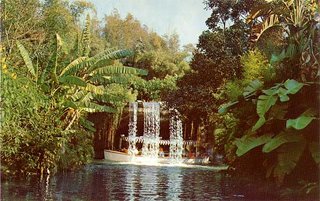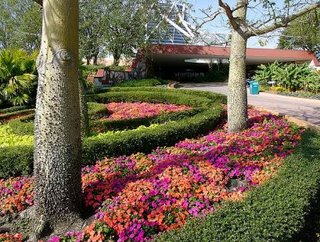 An opening day attraction at every Disney park but one, the original “E” ticket, one of the most conceptually and thematically advanced of pre-1964 Disney attractions, and the true heart of any Adventureland, The Jungle Cruise has been a Disney standard since 1955.
An opening day attraction at every Disney park but one, the original “E” ticket, one of the most conceptually and thematically advanced of pre-1964 Disney attractions, and the true heart of any Adventureland, The Jungle Cruise has been a Disney standard since 1955.It also seems to foster – or breed – eccentricity, for between the years of 1955 and 1994 The Jungle Cruise was the boy’s camp of Disneyland and Walt Disney World, and begat it’s own set of bizarre wisecracks, pranks, and traditions bred out of giving young men a boat, a gun, and a lot of really fake animals to talk about – over and over and over again.
The Jungle Cruise has never been subject to much close scrutiny by fans, possibly because of the evident “hokiness” of the ride vis-à-vis modern sensibilities and attractions Disney has been building since 1967. It also fails to suggest an endlessly explorable “mythology” such as in Pirates of the 
The Jungle Cruise is Adventureland.
Of course subsequent expansions have made Adventureland, as a unit, more diverse, but all the way up until 1994 all attractions were built in order to aid the Jungle in mind: The Enchanted Tiki Room neatly matches the “faux Polynesia” tone evoked by the Jungle Cruise boathouse; The Tahitian Terrace continued the tradition of live music accompanying your return to civilization; and the Swiss Family Treehouse was perfectly perched to allow a spectacular view of the rivers of Adventure. But even the all-encompassing hold of Disneyland’s Indiana Jones Adventure, a modern E-Ticket unmatched anywhere in the world, is not enough to dilute the river’s power: despite efforts to age the boats, adapt the spiel, theme the dispatch area and generally impose itself on the then-45 year old attraction, The Jungle Cruise still seems to be the most important thing in the area. In terms of hogging pure real estate in the pantheon of Disney attractions it is matched only by The Mine Train Thru Nature’s Wonderland and 20,000 Leagues Under the Sea, themselves simply variations of the Jungle Cruise model. Indeed, for the first several years of operation, the attraction’s sign read simply “ADVENTURELAND” and all other buildings in the area were built only to create a backdrop for it.
That early attraction was really the brainchild of Harper Goff, the design genius who gave us the Nautilus in 20,000 Leagues Under the Sea. As is commonly reported by seemingly everyone, the original plan called for real animals, but after various biologists convinced Walt Disney that their care and display would be utterly impractical, Goff offered to design Disney a “Hollywood Jungle”, where animals would threaten boats on cue. It worked.
The early version of the attraction was dependant on Bill Evans’ careful landscaping as much as on Goff’s scenic design and Bill Mattey’s mechanical animals, and between the three of these men most of the credit for the first eight years jungle launches can be attributed. Goff’s major set pieces, such as the candy-striped boats themselves, the early Cambodian shrine overrun by mechanical monkeys, and the magnificent  turning out of sight, and trucks were driven through the dry riverbeds to give the designers an approximation of how well this effect would come off.
turning out of sight, and trucks were driven through the dry riverbeds to give the designers an approximation of how well this effect would come off.
And such was the Jungle Cruise, for a time. By 1956 mechanical quirks had been worked out of the system and the animals were now controlled pneumatically, a practice which continues to this day. In 1957 a human presence was added to the dangerous
By the early sixties Walt had tapped famed animator Marc Davis to take a look around 
Marc Davis' Cambodian Ruins, faithfully executed.

The other major scene he developed was the Great African Veldt, which in its early years featured lions menacing guests with a bloodied zebra carcass, which was brilliantly offset by his famous and comical “Trapped Safari” scene immediately thereafter. The skippers, originally delivering a semi-educational if sometimes dryly comic narration, began to gradually modify the spiel to take advantage of
Return next week for more photos and Part Two!





